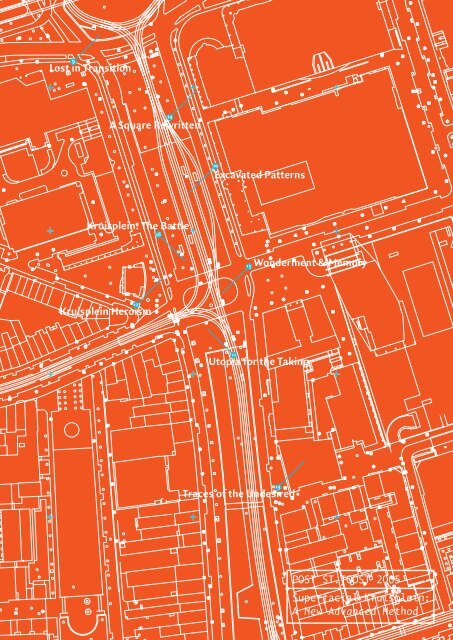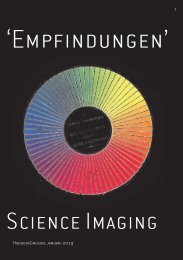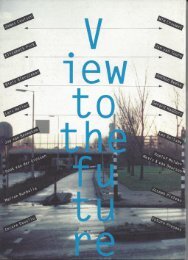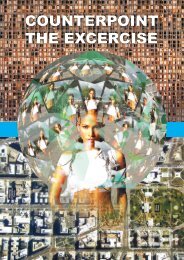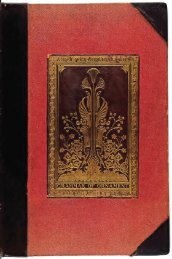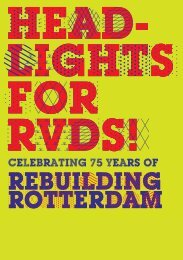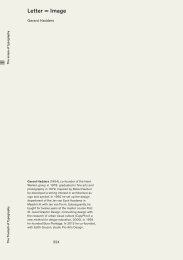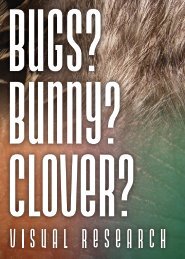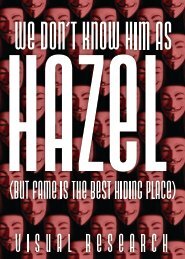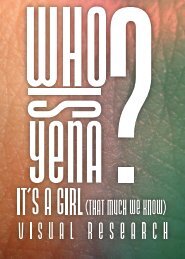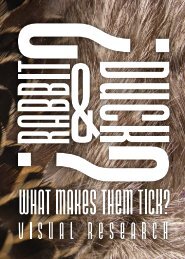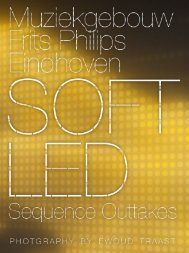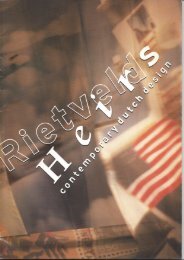Post St.Joost 2005, Superfacial Kruisplein: A New Advanced Method
Teaching a method makes future designers independent of style or medium. Applying a design method ensures a design process that is controllable, interactive and suited for dealing with the utmost complexity. A method withstands the trap of purely aesthetic assessment of the product. A method implies an abstract level of design development that tilts the traditional understanding of graphic design as a manual, problem-solving discipline. Instead it introduces a much more advances notion of graphic design as an open minded, research-based, strategic approach to visual communication.
Teaching a method makes future designers independent of style or medium. Applying a design method ensures a design process that is controllable, interactive and suited for dealing with the utmost complexity. A method withstands the trap of purely aesthetic assessment of the product. A method implies an abstract level of design development that tilts the traditional understanding of graphic design as a manual, problem-solving discipline. Instead it introduces a much more advances notion of graphic design as an open minded, research-based, strategic approach to visual communication.
You also want an ePaper? Increase the reach of your titles
YUMPU automatically turns print PDFs into web optimized ePapers that Google loves.
‘05
1.Table of Contents<br />
2. Introducing <strong>Superfacial</strong>:<br />
<strong>New</strong> <strong>Advanced</strong> <strong>Method</strong><br />
3. Why a method ?<br />
4. What method ?<br />
5. Why the <strong>Kruisplein</strong> ?<br />
6. <strong>Kruisplein</strong> image<br />
7. Invisible <strong>Kruisplein</strong><br />
8. <strong>Kruisplein</strong> Info Map<br />
Design Projects: Part 1<br />
9. Debbie van Berkel<br />
10. Rob de Bree<br />
11. Luis Castañeda<br />
12. Dirk Claessens<br />
Design Projects: Part 2<br />
13. Marjolein Kloet<br />
14. Inka Resch<br />
15. Willemijn Schellekens<br />
16. Maarten Verweij
2. Introducing <strong>Superfacial</strong><br />
<strong>New</strong> <strong>Advanced</strong> <strong>Method</strong><br />
3. WHY A METHOD?<br />
Teaching a method makes future designers independent of style or medium.<br />
Applying a method ensures a design process that is controllable, interactive and<br />
suited for dealing with the utmost complexity.<br />
A method withstands the trap of purely aesthetic assessment of the product.<br />
A method implies an abstract level of design development that tilts the traditional<br />
understanding of graphic design as a manual, problem-solving discipline Instead<br />
it introduces a much more advanced notion of graphic design as a open minded,<br />
research-based, strategic approach to visual communication.<br />
4.<br />
WHAT METHOD?<br />
The <strong>Post</strong> <strong>St</strong>. <strong>Joost</strong> method chooses the urban environment of the city as a prime reference to<br />
gain insight into the level of complexity designers are faced with today in dealing with visual<br />
communication. The city provides both an experience we all share, and a mass of signs that<br />
probably nobody fully grasps. In contrast to television and the internet where navigation<br />
takes place through ‘exclusion’, urban space presents us with the maximum of ‘static’. We<br />
move through urban space by ‘inclusion’, meaning the appropriation of a visual culture we<br />
do not necessarily understand or even want to understand. <strong>St</strong>ill, appropriation is needed<br />
dearly to be able to navigate through urban space.<br />
Graphic designers should prepare to step into the gap between the producers of urban space<br />
and the users of urban space and bring their discipline of interface-design to a much higher<br />
level of political and organizational complexity, and to a much larger scale. It means that they<br />
will have to learn to grasp, read, scan and analyze the city’s facades as carriers and machines<br />
of visual communication.<br />
Central to the training of designers for projects that deal with visual communication of urban<br />
identity is that they learn to immerse themselves in the seemingly endless visual and identity-complexity<br />
of the city, but are also able to emerge with compact packages that they can<br />
design with. This means a temporary suspension of their wish to know, control and understand<br />
everything in the beginning, and also an end to their tendency to endlessly doubt and<br />
hesitate over the why and the how in the second phase of the process.<br />
What needs to be drilled into them is firstly the courage to dive into a situation of total<br />
unreadable chaos or emptiness, and secondly the level of control and assurance needed to<br />
make choices and stick to them.<br />
The method to achieve this type of training of Urban Graphic Designers (an ambition for the<br />
years to come) is coined ‘SUPERFACIAL’. The next 8 individual thesis projects will explain and<br />
visualize the succession of steps that constitute SUPERFACIAL in the current curriculum.
5.<br />
WHY THE KRUISPLEIN ?<br />
The location of the <strong>Kruisplein</strong> in Rotterdam was chosen for its inherent complexity. It functions<br />
mainly as an assembly point for streetcars that need to reach the central Rotterdam<br />
train<br />
station. So... the main slab of the square is covered with rails, and undesigned pavement<br />
consisting of a catalogue of paving possibilities in the last quarter century and even some<br />
trees and grass. The surface of the square says: “I don’t know, leave me alone”. But around<br />
the square there exists a strange ‘big city’ amalgamate of office buildings, hotels, a large<br />
concert hall, a music and dance conservatory, a cinema megaplex, a mini Chinatown and a<br />
drug shelter in a church. The architecture ranges from late 19th century city construction to<br />
early 21” century expansions with all the periods that are in the middle represented too. The<br />
users range from beggars to hot-rodded petty dealers to senior classical music afficionados<br />
to corporate lawyers that set out during lunch to get their falafel in the street. The nationalities<br />
that roam there are uncountable and so are the different age groups and ‘city-tribes’.<br />
This exercise sets out to cater to only one of the users, to make the <strong>Kruisplein</strong> more comfortable<br />
for just one subject. We get there by analyzing the place, choosing a user-character,<br />
fictionalizing this character and amplifying his or her view on the <strong>Kruisplein</strong>, creating<br />
a tailor-made comfort-giving device and introducing this back into the area. During this<br />
process we hop several times from group to individual activity. To assist in this process the<br />
team includes a creative writer and an architectural historian. This project builds on the<br />
preliminary short exercise in Paris and even more so on the ‘Poetry HST Project’ which deals<br />
with the introduction of text and image in the railway station area of Breda. As we will see in<br />
the course of the exercise, the <strong>Kruisplein</strong> area was expanded to both Kruiskades that sit on<br />
either side of the street crossing that was the original name given to the current larger area.<br />
6.
The users range<br />
from beggars to<br />
hot-rodded petty<br />
dealers to senior<br />
classical music<br />
aficionados to<br />
corporate lawyers<br />
that set out<br />
during lunch to<br />
get their falafel<br />
in the street.
INVISIBLE KRUISPLEIN<br />
In a collaborative effort the students compiled data and information on a broad range of<br />
topics closely related to the <strong>Kruisplein</strong>, but hardly readable from its surface. The Invisible<br />
<strong>Kruisplein</strong> project researched themes which included social structures, ownership, history &<br />
7.<br />
urban planning, and infrastructure.
invisible kruisplein_ infomap_title
Zoning
Zoning<br />
<br />
<br />
<br />
oning<br />
Zoning
Ownership<br />
Social <strong>St</strong>ructures
Infrastructure
10. Rob de Bre<br />
Design Projec<br />
9. Debbie va<br />
11. Luis Casta<br />
12. Dirk Claes
ts: Part 1<br />
Berkel<br />
e<br />
ñeda<br />
sens
9.<br />
Debbie van Berkel<br />
<br />
Both the initial <strong>Kruisplein</strong> Comfort project and the investigation leading<br />
up to Lost in Transition, the final thesis, are about patterns of movement<br />
at the <strong>Kruisplein</strong>. Maybe more precisely put, they are about the sense of<br />
disorientation and the way to escape from there into a state of... A state<br />
of... A state of poetic reassurance. <strong>Kruisplein</strong> Comfort turns the act of<br />
walking of a single woman into dance with a partner. Replaces insecurity<br />
with ritual. Couples the banal to the sublime. Anxiousness is turned into<br />
enjoyment by the shear change of pace and motion. Single becomes couple.<br />
Vulnerability dissolves into intangibility.<br />
The second case of disorientation is derived from the actual situation<br />
at the entrance of the <strong>Kruisplein</strong>. Building activities have not only obscured<br />
the views towards the city for all those passengers arriving at Rotterdam<br />
Central <strong>St</strong>ation, they have also destroyed any predictable pattern of<br />
movement from there on.<br />
For the next five years this part of the <strong>Kruisplein</strong> will be a wasteland<br />
of fences, ditches, machines and other obstacles that will cause permanent<br />
discomfort and disorientation. Temporary signs and notices are meant to<br />
|direct vast amounts of people to their destinantions, but their impact is<br />
low. The aim of manipulation is obscured by the irregularity of the official<br />
routing system. Because signs have to be modified or re-hung practically<br />
every single day an ever more confusing pattern arises.<br />
Unintentionally it seems to give rise to a new approach to this kind of<br />
battlefield signage. Why not cash in on the confusion? Accept that no system<br />
at least in situations like these will be able to direct travellers from A to B<br />
in a proper way and instead explore the possibilities of helping people to<br />
get lost in this archeological site. A change of perspective might help people<br />
realise that walking astray will not only lead to lost time, but maybe also to<br />
new insights. Signs will no longer predict the answer, but rather pose the<br />
question. They will not satisfy their need for certainty but examine why<br />
certainty appears to be such a valuable asset to the modern traveller.<br />
Great findings have resulted from derailed scientific research. And what<br />
about derailed walking? For the next five years the <strong>Kruisplein</strong> area could<br />
be a laboratory, a poetic circus and a fair excuse for being late.
Poetry in Urban Space<br />
Breda Railway Zone<br />
First year <strong>Post</strong> <strong>St</strong>. <strong>Joost</strong>, 2004<br />
<br />
<br />
<br />
<br />
<br />
<br />
<br />
<br />
<br />
<br />
<br />
<br />
<br />
<br />
<br />
<br />
<strong>Superfacial</strong><br />
<strong>Kruisplein</strong> Comfort<br />
First year <strong>Post</strong> <strong>St</strong>. <strong>Joost</strong>, 2004<br />
Scanning the <strong>Kruisplein</strong>
Physical_movement<br />
Creating a character from the <strong>Kruisplein</strong> by writing a poem.<br />
Visualizing the poem: Character is walking home on her habitual route.<br />
Schggggtrrr ting…<br />
Kdngg…kdngg kdngg,<br />
Kdngg kdngg…kdngg kdngg,<br />
schgggtrrr tinggg tinggg tinggg.<br />
Schggggtrrr ting…<br />
Kdngg…kdngg kdngg,<br />
Kdngg kdngg…kdngg kdngg,<br />
schgggtrrr tinggg tinggg tinggg.<br />
Niemand die het hoort,<br />
Hetgeen mij zo stoort,<br />
Geluid, dansend in mijn hoofd,<br />
dat mijn lichaam verdooft,<br />
Nobody heard,<br />
The noise annoying me<br />
Sound, dancing in my head,<br />
That drugs my body,<br />
Zou hij, daar aan de overkant,<br />
na een stevige shot<br />
Altijd muziek horen,<br />
Dat is pas één en al genot,<br />
Maar ook zichzelf verloren.<br />
Would he, on the other side of the street,<br />
after a heavy shot<br />
Always hear music,<br />
That would be pure delight,<br />
But he had also loose himself<br />
Om de hoek<br />
Raakte ik zoek,<br />
Onaangenaam oog in oog,<br />
Hoe hij mijn lichaam op zoog,<br />
Around the corner,<br />
I’ve lost my way,<br />
Unpleasant eye to eye,<br />
The way he sucks up my body,<br />
Nare man, ontwijken, kon niet,<br />
Mijn terugreis zette ik voort,<br />
Hopelijk wordt ik niet weer gestoord,<br />
En concentreer me op wat ik zie,<br />
WOO HING HAY,<br />
Één… twee …drie,<br />
<strong>St</strong>ap en draai.<br />
HONG KONG GOLD,<br />
Zo elegant zijn hand rolt,<br />
Langst mijn lichaam,<br />
Niet onaangenaam,<br />
HAS KEBAB,<br />
Vier…vijf…zes,<br />
De laatste stap,<br />
Daar was de beleving weer,<br />
Dansen met hem,<br />
maakt mij als een veer<br />
Elke dag keer op keer.<br />
Nasty man, avoidance isn’t possible,<br />
I continue my journey,<br />
Hopefully, I won’t get disturbed again,<br />
I concentrate on what I see,<br />
WU HING HAY,<br />
One… two …three,<br />
<strong>St</strong>ep and turn,<br />
HONG KONG GOLD,<br />
So elegant how his hand caresses<br />
My body,<br />
Very pleasant,<br />
HAS KEBAB,<br />
Four…five…six,<br />
The last steps,<br />
Here comes that experience again,<br />
Dancing with him<br />
Makes me light as a feather<br />
Every day again.<br />
1 flat house<br />
Woo Hing<br />
Chinese haircutter<br />
Videotheek<br />
Hong Kong<br />
travel service<br />
Wah Nam Hong<br />
house<br />
Entrance<br />
Chinese<br />
supermarket<br />
Dim Sum<br />
Chinese Muur<br />
acupuncture<br />
Exit Chinese<br />
supermarket<br />
Bram Ladage<br />
French Fries<br />
Sjoko<br />
Night Shop<br />
Grill resturant<br />
Turkish Speciality<br />
Living houses<br />
to parking<br />
GSM-shop.nl Printshop MulticopyTimpaan<br />
Yildiz Döner<br />
Monditel BV<br />
West-Kruiskade<br />
luxe schoenen<br />
(luxery shoes)<br />
Corbeau<br />
Hotel Restaurant<br />
nr.3 King's Garden<br />
nr.2<br />
Rotterdam CS<br />
used<br />
<strong>Kruisplein</strong><br />
tram 3, 4, 5, 8, 23<br />
not used<br />
tram 1, 7 (3, 4, 5, 8, 23)<br />
tram 1, 7 (3, 4, 5, 8, 23)<br />
Loyens Loeff<br />
Holiday Inn<br />
house Chinese shop<br />
Dansacademie<br />
Conservatorium<br />
Happy Sushi<br />
Multifoon<br />
Rijken & de Lange<br />
(piano store)<br />
Pathé<br />
Cinema<br />
Grand Palace<br />
Dim Sum<br />
schouwburgplein<br />
Doelencafé
Time, movement and repetition refer to rhythm. That’s why I built up the poem out of dots.
Lost in Transition<br />
Final project
Today<br />
Future plans<br />
IDEALISED view from the <strong>Kruisplein</strong> towards the station<br />
Ideal image Great expectations<br />
<br />
<br />
A five-year period is expected to generate<br />
these ideal plans, but will it mean five years<br />
of discomfort and disorientation?
efore after<br />
<br />
Beware of obstacles<br />
and dead ends.<br />
Sorry!<br />
Flyer City Council
The entrance to Rotterdam will be chaotic<br />
The habitual routes<br />
of daily travelers will<br />
change frequently.
Travelers have to avoid obstacles to reach their destination.<br />
For many people the transition period will disrupt<br />
their daily routine. Normally they can walk their route<br />
blindly, without thinking. That won’t be possible during<br />
the transition period. This will lead to disorientation,<br />
alienation, discomfort, frustration, stress…discovery...<br />
DISORIENTATION<br />
...is particularly frustrating<br />
LOSTTIME<br />
...is especially stressfull
‘Ga je mee verdwalen,<br />
ik weet de weg.’<br />
Loesje<br />
<br />
<br />
<br />
<br />
<br />
<br />
imaginationCAN CHANGE PERSPECTIVE<br />
imagination IS STATE OF MIND
A temporary signage system intended to direct the<br />
flow of traffic also has randomness and movement<br />
in it. The exisitng system has a formal visual language<br />
and changes frequently.
PROBLEMEN<br />
ZIJN GEEN<br />
STOPBORDEN<br />
(zij zijn richtlijnen)<br />
OMLEIDING<br />
Ga je mee dwalen<br />
ik weet de weg<br />
HITCH YOUR MIND<br />
TO A STAR<br />
EEN GEEST VOL<br />
VERTROUWEN ZAL ⇤<br />
JE ALTIJD DE GOEDE<br />
WEG WIJZEN<br />
ER ZIJN ALTIJD ALTERNATIEVEN<br />
standaard<br />
IF YOU ARE GOING<br />
THROUGH HELL<br />
KEEP GOING<br />
standaard
10.
SYNTHESIS RESEARCH MAP: The map above was used to plot the steps I took into the research for this<br />
final project. This chart has two beginning points, the first is the SuperFacial / Visible KP Project, in which<br />
I created a character the '20-Cents' man. The images for this character had been created from the visible<br />
scanning (photography, drawings) the group had made of the <strong>Kruisplein</strong> area. The second beginning point<br />
was when as a group we conducted the Invisible <strong>Kruisplein</strong> research. The idea to use a map as a guide<br />
came from the layered information map the whole 2nd year group had designed. Myself and a fellow student<br />
conducted interviews of the social organizations which exist in the area. I then charted a course where I<br />
eventually connect both starting points. For this project I continued what we started in the first year of study.
11.
12.
14. Inka Resch<br />
Design Projec<br />
13. Marjolein<br />
15. Willemijn<br />
16. Maarten V
ts: Part 2<br />
Kloet<br />
Schellekens<br />
erweij
13.
fourteen.
15.<br />
Willemijn Schellekens<br />
Wonderment and memory<br />
There is an obvious simalarity between the main characters of the two<br />
projects presented here. The statue cleaner in <strong>Kruisplein</strong> Comfort and<br />
Mr. <strong>Kruisplein</strong> in the thesis project both incorporate the capacity to<br />
maintain an overview of the square. His bird’s eye perspective on the<br />
<strong>Kruisplein</strong> enables the statue cleaner to record different scenes simultaneously.<br />
His position on the ladder detaches him from the crowd, while at<br />
the same time his profession turns him into an unmistakable part of the<br />
square. Hardly noticed, but fully aware of what is going on beneath him.<br />
<strong>St</strong>ill, his main focuses are the pigeons and their excrements – the ultimate<br />
reason for being there. He’s a flyer like they are. His fantasies are built<br />
around pigeons. They are the actual monuments on the square and most<br />
certainly his preferred companionship.<br />
Mr. <strong>Kruisplein</strong> is almost without companions. Surrounded by thousands<br />
of people he feels neglect and indifference. His image has grown old and<br />
weary. No one seems to notice the stories he has to tell and most of them<br />
have left no trace on him. Mr. <strong>Kruisplein</strong> has seen the ages pass by. He<br />
knows about the days before the bombing of Rotterdam. He witnessed<br />
the forbidden love affair between the little black boy of the Zoo and the<br />
director’s daughter. He engaged in public song and dance during the early<br />
20th century Queens Day celebrations. Such stories could reclaim their<br />
presence in public space. As an antidote against the shrinking identity<br />
of the place they would make people wonder about the history of the<br />
<strong>Kruisplein</strong>. Instead of the current alienation – a place of transit, a square<br />
to be forgotten – new perspectives on the <strong>Kruisplein</strong> would open up the<br />
views, mark areas of interest in this sea of nothingness. They will add<br />
a sense of belonging that revives the <strong>Kruisplein</strong> without the help of city<br />
planners, demolition experts and fashionable architects.
• 1st year project • <strong>Post</strong>-<strong>St</strong>.<strong>Joost</strong> • Willemijn Schellekens • end of june 2004 • Het <strong>Kruisplein</strong>; The pigeon Poet •<br />
The statue cleaner<br />
<br />
<br />
<br />
<br />
<br />
<br />
<br />
<br />
<br />
A change of perspective changes one's perception.
The perspective of the statue cleaner, when he is on his ladder, doing his job. The people don't<br />
notice him anymore, he has become part of the city. And this is what he experiences: --->
The statue cleaner is happy when he stands on his ladder and dreams about being the hero in a<br />
fantasy world of his own creation. Creating comfort for him means more statues to clean, more<br />
pigeons to shit, more opportunities for him to hide. But at the same time he would like to get in<br />
touch with the passers by as well. He does not always want to be invisible. So I ceated a language<br />
for him, to communicate in his subtile way. Nobody notices him, but if you look close, he is there!<br />
That's his message.<br />
I am here<br />
my way
• Thesis project • <strong>Post</strong>-st.<strong>Joost</strong> • Willemijn Schellekens • june <strong>2005</strong> • Het Kp; Memories of a shrinking man •<br />
I found mr. <strong>Kruisplein</strong>s<br />
diary. He is sad, and he<br />
will tell you why.<br />
<br />
Het<br />
<strong>Kruisplein</strong>;<br />
an old man,<br />
whose<br />
identity's been<br />
forgotten
The perception of a place is<br />
determined by the way people look.<br />
You donʼt need things<br />
in order to see<br />
Things need you<br />
in order to be seen<br />
-K.Schippers
Wonderment<br />
is the key<br />
to make people look<br />
in a different way<br />
at the <strong>Kruisplein</strong>.<br />
Things are not always what they<br />
seem<br />
Wonderment makes the ordinary<br />
extraordinary.<br />
Harmen de Hoop<br />
Wonderment is also a matter of<br />
perspective.<br />
What you see is what you think<br />
you see.<br />
Context is everything.<br />
Imagination is essential.<br />
And of course you have to believe<br />
or want to believe.
I believe in wonderment.<br />
And I’ve promised to help<br />
dear old friend mr. <strong>Kruisplein</strong>.<br />
<br />
<br />
<br />
<br />
<br />
So I’ve identified and redressed 5 of his<br />
memories, to make people look at the square<br />
in a different way and to give 5 elements of its<br />
identity back to public space:<br />
<br />
<br />
<br />
<br />
<br />
<br />
<br />
<br />
<br />
<br />
<br />
<br />
<br />
<br />
<br />
<br />
<br />
<br />
<br />
<br />
<br />
<br />
<br />
The <strong>Kruisplein</strong> was a<br />
place to dance,<br />
I make it a place to<br />
dance again.<br />
Busy bodies reflected the ladies<br />
of the Diergaardesingel, now peak<br />
and wonder again.<br />
An impossible love. The Diergaarde<br />
fence was a border<br />
between two worlds. Come and<br />
find out this hidden story.<br />
Children used to play in the rubble<br />
of the war. Now the <strong>Kruisplein</strong> is<br />
turned in a building site again.<br />
A new playground?<br />
The <strong>Kruisplein</strong> was a crime scene.<br />
Mr. <strong>Kruisplein</strong> was a witness.<br />
The mystery can still be solved, If<br />
you find the criminals portrait...
16.
ZONING + VIOLENCE
17.Colophon<br />
This is a publication of the<br />
<strong>Post</strong> <strong>St</strong>. <strong>Joost</strong> Academy,<br />
Graduate Program in Graphic Design;<br />
Avans Hogeschool, Breda,<br />
The Netherlands<br />
Text: Gert <strong>St</strong>aal & Gerard Hadders<br />
Design: R.J. de Bree, L.G. Castañeda<br />
with I.X. Resch & W.M. Schellekens<br />
Typefaces: Quadraat Sans<br />
Printers: Veenman Drukkers, Rotterdam<br />
Edition: 400<br />
Year <strong>2005</strong>


